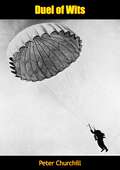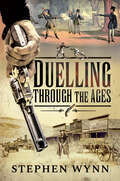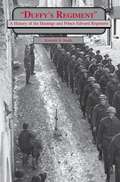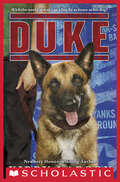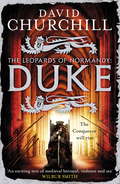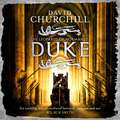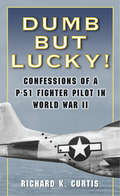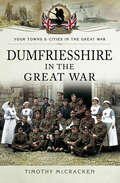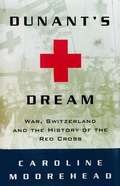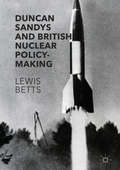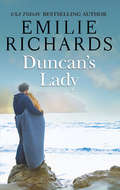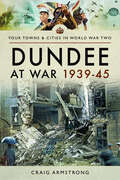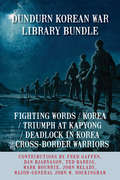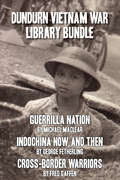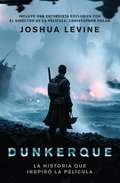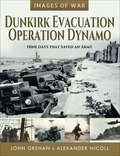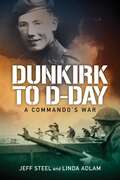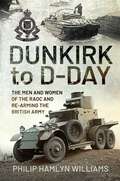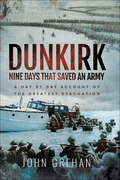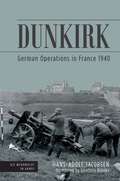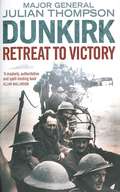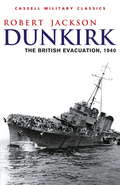- Table View
- List View
Duel of Wits [1955 US Edition]
by Peter ChurchillContains – “Of Their Own Choice” and “Duel of Wits” by SOE operative Captain Peter Churchill DSO.In Their Own Choice, he describes his initial training at Warnborough Manor, near Guildford, in sabotage, Morse code, use of firearms, bridge demolition, and French military drill; and then to the Scottish Highlands near Mallaig, for map reading, orienteering, weapons and explosives training, close combat, and physical training; and then parachute training at Ringway near Manchester. The final training was at the Finishing School at Beaulieu Abbey in the New Forest where he learnt railway sabotage, inconspicuous behaviour, codes, cover stories, how to build up networks, and how to behave under interrogation. Of 14 people who began the training, Churchill was one of only three who graduated.He was assigned to the French Section in June 1941, and given his French identity card with a false identity. His first mission was to be infiltrated into the French Riviera by submarine in order to inspect three SOE networks in Antibes, Marseille and Lyons, evaluate their strengths weaknesses, assess their needs, and give them instructions....In Duel of Wits Peter Churchill tells the story of his second submarine operation of board H.M. Submarine P42—Unbroken—commanded by Lieutenant-Commander Alastair Mars, D.S.O., D.S.C., and then goes on to describe his experiences as an organiser of Resistance in the south-east of France, where he spent many months as liaison-officer to a large group. This book includes the epic story of how Odette and Arnaud, racing against time, climbed a 6,000 feet snow-covered mountain in order to signal the bomber that was going to drop a parachute on to its summit. It tells of the arming of the first Maquis force and ends with the betrayal and capture of Odette and Michel.
Duelling Through the Ages
by Stephen WynnPutting aside Roman gladiators and gun-slingers of the American Wild West, by the 19th century duelling had become the sole domain of nobility, military officers and gentleman, with rules added to make sure everything was conducted in a fair and professional manner. The word 'honour' became popular, because it was the reason why most men would challenge another to a duel. This book challenges that notion and asks whether it was really about honour at all, or was it more about arrogance or social standing? Over time kings, leaders and governments passed rules, decrees, edicts and laws banning the practice, but still it continued, even when the duellists knew that the punishment for taking part in such an event could be their own death. The last known duel with swords in France took place at a private residence just outside of Paris in 1967 between two politicians, Gaston Deferre and Rene Ribiere. It was ended after Ribiere, who was due to be married the following day, was twice cut on the arm by Gaston. The book also looks at some of the more humorous, unusual and least expected ways people found to conduct their duels, including throwing billiard balls at each other, duelling whilst sat on the backs of elephants, and two men who decided their differences should be settled half a mile up in the sky in hot air balloons. With more efforts to bring about an end to duelling, the upper classes of British society in particular still held on to the idea of being able to defend their honour, which saw many of them turn to pugilism as a way to sate their disputes, however ridiculous they might appear today.
Duffy's Regiment: A History of the Hastings and Prince Edward Regiment
by Kenneth B. SmithThis is the gripping story of how one man’s half-century of service and devotion helped build and develop the Hastings & Prince Edward Regiment; and how that regiment played a vital role in Canada’s efforts during the Second World War. Angus Duffy was Regimental Sergeant-Major during the Second World War; commanding officer from 1958 to 1962, and Honorary Colonel from 1976 to 1981, an da man revered and respected for his tough but humane approach to leadership, and underlying belief that the common foot soldier was more important than the commissioned officer. Although he wasn’t commanding officer during the Second World War, there was little doubt that the Hastings & Prince Edward soldiers felt they were serving in Duffy’s Regiment. Illustrated with a number of captivating war photos, Duffy’s Regiment is a detailed, and often touching look at the impact one man had on his regiment, and the incredible sacrifice of those men.
Duke (Dogs of World War II)
by Kirby LarsonFrom a Newbery Honor author, a boy loans his dog to the US Army during World War II in this “incisive tale of loyalty, patriotism, sacrifice and bravery” (Publishers Weekly).Hanson is determined to do his part to help his family and his country, even if it means giving up his beloved German shepherd, Duke. Hoping to help end the war and bring his dad home faster, Hobie decides to donate Duke to Dogs for Defense, an organization that urges Americans to “loan” their pets to the military to act as sentries, mine sniffers, and patrol dogs. Hobie immediately regrets his decision and tries everything he can to get Duke back, even jeopardizing his friendship with the new boy at school. But when his father is taken prisoner by the Germans, Hobie realizes he must let Duke go and reach deep within himself to be brave. Will Hobie ever see Duke, or his father, again? Will life ever be the same?“Exceptionally well-crafted and emotionally authentic.” —Kirkus Reviews
Duke (Leopards of Normandy 2): An action-packed historical epic of battle, death and dynasty
by David Churchill**From the co-author of the No.1 bestselling Wilbur Smith novel, WAR CRY*The Conqueror will rise...The Leopards of Normandy trilogy continues with DUKE, as William of Normandy inherits his father's title and assumes command of his lands. David Churchill's 'exciting mix of medieval betrayal, violence and sex' (Wilbur Smith) is sure to enthral fans of Bernard Cornwell and Conn Iggulden.Normandy, 1037. Sparks fly from clashing swords as the game of thrones plays out in bloodshed. Of those named guardian to the boy Duke, all seek advantage and power. Most wish the boy dead. Some will go to any lengths to make it happen.Across the sea, the struggle for the English crown has seen Queen Emma's beloved son killed. She has two more sons waiting in the wings but Godwin, Earl of Wessex - kingmaker and arch manipulator - has other plans.As the noble families of Europe murder each other in their lust for power and fortune, the boy stands apart.His name is William. His destiny is to conquer.Don't miss the final instalment of The Leopards of Normandy trilogy, as Duke William prepares to take England by storm in CONQUEROR. What readers are saying about DUKE:'To read a novel linked by actual historic characters and events whilst still maintaining a racy narrative is quite something. A fantastic read''One of the best historical novels I have read. Well written, compelling, action-packed, good characters. This is seriously worth reading!'
Duke (Leopards of Normandy 2): An action-packed historical epic of battle, death and dynasty
by David Churchill**From the co-author of the No.1 bestselling Wilbur Smith novel, WAR CRY*The Conqueror will rise...The Leopards of Normandy trilogy continues with DUKE, as William of Normandy inherits his father's title and assumes command of his lands. David Churchill's 'exciting mix of medieval betrayal, violence and sex' (Wilbur Smith) is sure to enthral fans of Bernard Cornwell and Conn Iggulden.Normandy, 1037. Sparks fly from clashing swords as the game of thrones plays out in bloodshed. Of those named guardian to the boy Duke, all seek advantage and power. Most wish the boy dead. Some will go to any lengths to make it happen.Across the sea, the struggle for the English crown has seen Queen Emma's beloved son killed. She has two more sons waiting in the wings but Godwin, Earl of Wessex - kingmaker and arch manipulator - has other plans.As the noble families of Europe murder each other in their lust for power and fortune, the boy stands apart.His name is William. His destiny is to conquer.Don't miss the final instalment of The Leopards of Normandy trilogy, as Duke William prepares to take England by storm in CONQUEROR. What readers are saying about DUKE:'To read a novel linked by actual historic characters and events whilst still maintaining a racy narrative is quite something. A fantastic read''One of the best historical novels I have read. Well written, compelling, action-packed, good characters. This is seriously worth reading!'
Duke (Leopards of Normandy 2): An action-packed historical epic of battle, death and dynasty
by David Churchill**From the co-author of the No.1 bestselling Wilbur Smith novel, WAR CRY. **The Leopards of Normandy trilogy continues with Duke, as William of Normandy inherits his father's title and assumes command of his lands. This vibrant series by David Churchill will enthrall fans of Bernard Cornwell and Conn Iggulden. 'An exciting mix of medieval betrayal, violence and sex' Wilbur Smith.Normandy, 1037. Sparks fly from clashing swords as the game of thrones plays out in bloodshed. Of those named guardian to the boy Duke, all seek advantage and power. Most wish the boy dead. Some will go to any lengths to make it happen.Across the sea, the struggle for the English crown has seen Queen Emma's beloved son killed. She has two more sons waiting in the wings but Godwin, Earl of Wessex - kingmaker and arch manipulator - has other plans.As the noble families of Europe murder each other in their lust for power and fortune, the boy stands apart. His name is William. His destiny is to conquer.(P)2016 Headline Digital
Dumb but Lucky!
by Richard CurtisSecond lieutenant Dick Curtis arrived in Italy in May 1944-twenty years old and part of a shipment of P-51 Mustang fighter pilots so desperately needed that they were rushed into combat with less than thirty hours of flight time in their new high-performance aircraft. Six of the twelve pilots assigned to the 52nd Fighter Group were shot down in the first two weeks. By his ninth mission, Curtis was the only one still flying. A maverick, he barely escaped court-martial with his high-flying antics. Escorting bombers sent to pound heavily defended oil fields was risky enough, but strafing the enemy supply lines, ports, and airfields was even more dangerous. Curtis may chalk up his success to dumb luck, but these missions took exceptional skill and courage. This hair-raising account captures the air war in all its split-second terror and adrenaline-pumping action. From the Paperback edition.
Dumfriesshire in the Great War (Your Towns & Cities in the Great War)
by Timothy McCrackenIn Dumfriesshire, the most striking change during the Great War was to occur around Gretna. Here the largest cordite factory in the UK was established, work commencing on the factory in 1915, with completion in 1916.Throughout the region the impact of the First World War was felt greatly by the local communities, which were decimated by the losses suffered during the conflict. The huge influx of workers to H.M. Factory Gretna disrupted areas of daily life and caused an increase in crime. The population of Dumfriesshire supported those who directly suffered as a result of the war, in a number of ways, including the production of wound dressings, the provision of auxiliary hospitals and fundraising efforts to provide support to refugees.Thematic chapters, considering aspects such as recruitment, voluntary medical service and commemoration, illustrate experiences of the Dumfriesshire population, shaped by the First World War.The book contributes to wider understanding of the impact of the First World War, particularly in rural areas, and as such will be of relevance to readers with an interest in cultural and social history.
Dunant's Dream: War, Switzerland and the History of the Red Cross
by Caroline MooreheadThe Red Cross was the dream of the Swiss businessman Henri Dunant that grew into the preeminent international humanitarian charity. The story begins in 1859, when almost by chance, Dunant witnessed the butchery and lack of care for injured soldiers during the battle of Solferino. Realizing that, although modern warfare meant more, and worse, wounded, medical treatment for the first time could save significant numbers of them, he began a crusade leading to 137 national societies and 250 million members today. Caroline Moorehead, a popular columnist on human rights for the London Independent, is the first writer to be granted wide access to the Red Cross's closed archives in Geneva. Her resulting book engrossingly recounts the Red Cross's full history and the moral dilemmas it has faced from the two World Wars to the post-Cold War conflicts of Somalia, Chechnya, and Bosnia.
Duncan Sandys and British Nuclear Policy-Making
by Lewis BettsThis book offers new perspectives on British nuclear policy-making at the height of the Cold War, arguing that the decisions taken by the British government during the 1950s and 1960s in pursuit of its nuclear ambitions cannot be properly understood without close reference to Duncan Sandys, and in particular the policy preferences that emerged from his experiences of the Second World War and his efforts leading Britain's campaign against the V-1 and V-2. Immersing himself in this campaign against unmanned weaponry, Sandys came to see ballistic missiles as the only guarantor of nuclear credibility in the post-war world, placing them at the centre of his strategic thinking and developing a sincerely-held and logically-consistent belief system which he carried with him through a succession of ministerial roles, allowing him to exert a previously undocumented level of influence on the nature of Britain's nuclear capabilities and its approach to the Cold War. This book shows the profound influence Sandys' personal belief system had on Britain's attempts to acquire a credible nuclear deterrent.
Duncan's Lady (Heartbreakers #2)
by Emilie RichardsNew to e-book, a classic romance from USA Today bestselling author Emilie Richards…Originally published in 1995When Duncan Sinclair needs a safe haven for his young daughter, the small Scottish town ofhis childhood is a godsend. He wants them to live a simpler life, away from the dramainvoked by his ex.When he meets Mara MacTavish, he is overcome. There is something very special abouther—she seems connected to the Highlands themselves, with a beguiling nature that bothcompels and concerns him. The last thing Duncan wanted was to fall for another charismaticwoman. But this time may be different…and Mara may be just what he, and his daughter,both need.Don't miss the other two books in the Men of Midnight series—Iain Ross's Woman andMacDougall's Darling.
Dundee at War 1939–45
by Craig ArmstrongDuring the Second World War a number of industries in Dundee were of importance to the war effort. The jute industry, which had previously dominated the local economy, had suffered badly during the 1930s. However, the war gave a temporary boost to the industry with as the material was in high demand for use in sandbags. The shipbuilding industry was also important, with the Caledon Yards being busy throughout the war. The yard refitted two Polish submarines at the beginning of the war and constructed a number of Castle and Loch Class frigates, as well as a number of merchant vessels. With its strategic importance it was believed that Dundee would be an obvious target for the Luftwaffe. Fortunately, however, Dundee escaped relatively unscathed and the city itself was only bombed on twenty-four occasions. Dundee also played a significant role in the war at sea, the city being home to a major Royal Navy submarine base, HMS Ambrose. Consequently, sailors came to be an important part of the wartime scene in Dundee and came not only from Britain and its Empire, but also from France and Norway. A great many Dundee men and women served in the armed forces during the war and the city suffered many casualties, but many also received decorations as a result of their bravery. Amongst them was Wing Commander Gordon Hugh Malcolm, who received the first RAF VC awarded for action in North Africa.
Dundurn Korean War Library Bundle
by Ted Barris Mark Bourrie Dan Bjarnason John Melady Fred GaffenThis ebook bundle contains five books that chronicle Canada’s participation in the conflict that gripped the Korean peninsula from 1950–53 and resulted in two very different nations that remain at odds today. This bloody and traumatic face-off between capitalist and communist ideologies highlighted the tensions of the Cold War that drew in nations from many parts of the world. Canadian soldiers did their part and many sacrificed their lives for the democratic cause. Those interested in the war and the Canadian role in it will find a wealth of information and analysis in this collection of works by leading historians. IncludesCross-Border WarriorsDeadlock in KoreaFighting WordsKoreaTriumph at Kapyong
Dundurn Vietnam War Library Bundle: Guerrilla Nation / Indochina Now and Then / Cross-Border Warriors
by George Fetherling Michael Maclear Fred GaffenThe Vietnam War was a regional conflict that turned into an epic confrontation between ideologies, leaving deep scars on the psyches of nations that fought and long-lasting physical damage to Vietnam itself. The three books in this bundle cover different aspects of the war and the region, from Michael Maclear’s personal memories as an embedded journalist in North Vietnam to George Fetherling’s observations of the state of Southeast Asia today to military historian Fred Gaffen’s analysis of the experiences of soldiers travelling to faraway lands to fight in their countries’ wars. Includes Cross-Border Warriors Guerrilla Nation Indochina Now and Then
Dunkerque
by Joshua LevinePronto una gran película de Christopher Nolan.La épica historia de Dunkirk, mayo de 1940: cuando más de 300.000 tropas aliadas atrapadas fueron dramáticamente rescatadas de la destrucción a manos de la Alemania Nazi por una extraordinaria evacuación vía marítima.La historia real de los soldados, marineros, aviadores y civiles implicados en la evacuación durante los nueve días desde el 27 de mayo a 4 de junio de 1940 se ha convertido en leyenda.Ahora el tema de la película del director Christopher Nolan, protagonizada por Kenneth Branagh, Tom Hardy, Cillian Murphy, Mark Rylance y Harry Styles. La historia que Winston Churchill describió como un «milagro» es detallada por el autor best seller Joshua Levine en su contexto completo y avasallador.Incluye nuevas entrevistas con veteranos y supervivientes, este libro va más allá de las escenas para explorar la vida real de esos soldados, bombardeados y ametrallados en las playas durante días, sin comida ni municiones; los civiles cuyas embarcaciones fueron sobrecargadas; los aviadores que arriesgaron sus vidas para comprarle tiempo valioso en tierra a sus compañeros; y aquellos que no lograron escapar.Contada desde las perspectivas terrestre, marítima y aérea, Dunkirk™ por Joshua Levine es una narración dramática de esta gloriosa derrota.
Dunkirk Crescendo (The Zion Covenant, Book #9)
by Bodie Thoene Brock ThoeneAS SPRING 1940 UNFOLDS IN PARIS, war is inevitable. AP journalist Josephine Marlow is asked to undertake a dangerous journey back into the borders of the Reich--just when the Führer is gathering his forces for another invasion. If she is successful, a child will live. If not, he will die. And many other children, too. French colonel Andre Chardon knows that the undefeated Führer will not hold back his Blitzkrieg long from France. But the plan of attack revealed in a coded message is so audacious that no one believes Andre. Whom can he convince? Who will have the courage to act before thousands of innocents are slaughtered? And is a miracle at Dunkirk Harbor possible?
Dunkirk Evacuation, Operation Dynamo: Nine Days that Saved an Army (Images of War)
by John Grehan Alexander Nicoll&“Takes you right to the scene of the action in late May and early June 1940, when more than 300,000 soldiers were saved from capture or death.&” —Rambles The &“miracle&” of Dunkirk is one of the most inspiring stories of all time. The British Expeditionary Force had been all but surrounded, and, with the French armies collapsing on all sides, it appeared that Britain was about to suffer the heaviest defeat in its history. When Winston Churchill&’s War Cabinet finally accepted that the Battle of France had been lost, preparations were made to try and rescue as many soldiers as possible from one of the few ports left open to the British Expeditionary Force—Dunkirk. So rushed and chaotic was the retreat to the Channel coast, with thousands of guns, vehicles and tanks being abandoned, there was little time for soldiers to consider taking photographs of the shocking scenes of death and destruction which surrounded them. Yet images do exist of the ships and boats of all descriptions which braved the bombs and guns of the German Air Force to rescue Britain&’s only field army from the clutches of Hitler&’s panzer divisions. One man in particular, Sub-Lieutenant John Rutherford Crosby, a member of the crew of the minesweeper, and converted Clyde paddle steamer, HMS Oriole, left a legacy of dramatic images. These include the never-to-be-forgotten scenes of long lines of tired and anxious troops stretching into the sea and of bombs exploding on the packed beaches—all with his own personal little camera. Other images in this book paint a vivid and memorable picture, as no words ever could, of the greatest evacuation of troops under fire.
Dunkirk to D-Day: A Commando's War
by Jeff Steel Linda AdlamAnother rip-roaring World War II history by prize-winning author Jeff Steel.Bill Adlam&’s hair-raising escape from Dunkirk, his dramatic commando raids and his storming the D-Day beaches reads like fiction. It all happened.Bill escaped the Dunkirk disaster via a bayonet charge into Nazi machine guns. He was presented with the Military Medal &‘for gallantry under fire&’ by King George VI. Bill volunteered for commandos: he thrived on adrenaline. Number 4 commando took him to a surgical strike in the north of Norway. The stated objective: to destroy oil installations. It was a feint. Ian Fleming of the Secret Intelligence Service had masterminded the raid. Its objective: to help break the Enigma Code. Number 4 Commando then sent him on a raid to Dieppe to spike naval guns to enable a landing by Canadian forces. Bill&’s commanding officer was Lord Lovat: cousin to Ian Fleming and (allegedly) template for the fictional James Bond. Bill&’s prowess as a commando saw him headhunted to a top-secret location in the wilds of Scotland. Here he trained others in the dark arts of &‘butcher and bolt&’.On D-Day morning Bill passed over the sands of Normandy in minutes. The next two months saw him up against Hitler&’s elite army and Waffen SS divisions. The reader will ask the same question that Bill asked: how would he ever come out alive?
Dunkirk to D-Day: The Men and Women of the RAOC and Re-Arming the British Army
by Philip Hamlyn WilliamsAt Dunkirk, the withdrawing army left behind most of its equipment, yet only four years later, on D-Day, troops would wonder at the efficiency of supply. This book looks at the lives of some of the men who led the monumental effort which led to this result. The story begins in Victorian south London. It goes out to Portuguese East Africa and then to Malaya, before being caught in the maelstrom of the Great War. Between the wars, its leading characters work at Pilkington, Dunlop and English Steel; they serve in Gallipoli, Gibraltar and Malta; they transform the way a mechanised army is supplied. They supply in the desert and the jungle. They build massive depots, and relationships with motor companies here and in the USA. After the war they work for companies driving the post-war economy: Vickers, Dunlop and Rootes. Many died, exhausted, years before their time.
Dunkirk: A Day-by-Day Account of the Greatest Evacuation (Images Of War Ser.)
by John GrehanThe epic of Dunkirk has been told many times, but the numerous accounts from surviving soldiers and sailors were often a blur of fear and fighting with the days mingling into each other, leaving what is, at times, a confusing picture. In this book, adopting a day by day approach, the author provides a clear portrayal of the unfolding drama on the perimeter around Dunkirk, in the port itself and along the beaches to La Panne and the Belgian border.Reports from many of the captains of the vessels which took part in the great evacuation were submitted to the Admiralty immediately after the conclusion of Operation Dynamo. With access to these, and supported by the various records maintained by the Army and RAF, the author has been able to finally piece together the movements and actions of the many of the squadrons, units and ships involved.With the Admiralty reports and a mass of other firsthand accounts, many of which have never been published before, the true tale of the heroism of the rescued and the rescuers is laid bare. Operation Dynamo saw civilian volunteers and Royal Navy personnel manning every type of craft from the antiaircraft cruiser HMS Calcutta to the cockle boats of the Thames Estuary. The accounts of the men who crewed these vessels tell of being bombed and strafed by the Luftwaffe or shelled from the shore. There are stories of collisions in the dark, chaos on the beaches and tragic losses as ships went down. Similar tales are told by the men waiting on the beaches, defending the perimeter or flying in the skies overhead in a valiant effort to hold the German Army and Luftwaffe at bay.Yet this is ultimately a story, as Churchill described it, of deliverance, for against all the predictions, the BEF was saved to fight again another day. With civilians and servicemen working without respite for days and nights on end under almost continual attack to rescue the army, the nation pulled together as never before. It truly was Britains finest hour.
Dunkirk: German Operations in France, 1940 (Die Wehrmacht im Kampf)
by Hans-Adolf JacobsenThe German Army invaded France on 10 May 1940, and in just over ten days their rapid advance, led by three panzer corps, had left three French field armies, Belgian forces and the British Expeditionary Force with their backs to the sea, trapped along the northern coast of France. General Gort realized that evacuation was the only option, and so began a chaotic withdrawal towards the port of Dunkirk. While the Luftwaffe continued to attack pockets of Allied forces, the German ground forces were ordered to halt their advance on 22 May. These orders were changed four days later, but these crucial four days of inaction allowed the Allies time to retreat into Dunkirk and prepare a defensive perimeter. The fighting during the last days of May was desperate, with the remnants of the French First Army surrounded at Lille, holding off seven German divisions until finally forced to surrender, and the Belgian Army forced to capitulate to the east of Dunkirk. Though the cost was devastatingly high, Dunkirk was held long enough for over 300,000 Allied troops to be evacuated back to England, with the remainder of the rearguard of French troops surrendering on 4 June. The British narrative of the retreat and evacuation that prompted perhaps Winston Churchill's most famous wartime speech has always been well-known; however only now is Hans-Adolf Jacobsen's detailed account of the battle from the German perspective available in English.
Dunkirk: Retreat to Victory
by Julian ThompsonA gripping account, Dunkirk reveals the British Expeditionary Force's (BEF) brave stand against the German army and the dramatic rescue of 338,000 British troops from the beaches of Dunkirk in the midst of World War II. In May 1940, the small BEF was sent to help the Belgians and French against advancing German forces. Ill-equipped and under-trained, the Allied troops conducted a fighting withdrawal in the face of the formidable Germans. Winston Churchill feared that nearly all of the BEF would be killed or captured, but thankfully most were rescued and a defeat was turned into a victory-one that lives on in the annals of history.General Julian Thompson draws from previously unpublished and rare materials to recreate the action on the beaches of the small town-from the misunderstandings between the British and French generals to the experiences of the ordinary soldier trying to fend for his life and return to his homeland. Unlike other books on the subject, Thompson's account gives full weight to the fighting inland as the BEF found itself in mortal danger due to the Belgian army's collapse on one flank and the French troop's failure on the other flank. Thompson aims to correct popular myths about the evacuation and set the history straight once and for all about the events that unfolded in May 1940.
Dunkirk: The British Evacuation 1940 (Sven Hassel War Classics)
by Robert JacksonA gripping account of the most famous military defeat and retreat in history, now the subject of a major motion picture, written and directed by Christopher Nolan and starring Kenneth Branagh, Tom Hardy and Mark Rylance.The NEW YORK TIMES of 2 June 1940 summed up the greatest disaster in British history thus: 'As long as the English tongue survives, the word 'Dunkirk' will be spoken with reverence.'This book tells the story of the Dunkirk evacuation. It traces the fortunes of the British Expeditionary Force during those dark days of May 1940 when boys armed with little more than rifles took on the might of Hitler's Panzer divisions - and held them while Allied armies crumbled on all sides. The evacuation at Dunkirk lifted more than 338,000 men from France to the safety of Britain using everything from Destroyers to pleasure yachts. It was the biggest single defeat ever suffered by British arms, but it was also one of the most astounding exoduses in history.
Dunkirk: The British Evacuation, 1940
by Robert JacksonA gripping account of the most famous military defeat and retreat in history, now the subject of a major motion picture, written and directed by Christopher Nolan and starring Kenneth Branagh, Tom Hardy and Mark Rylance.The NEW YORK TIMES of 2 June 1940 summed up the greatest disaster in British history thus: 'As long as the English tongue survives, the word 'Dunkirk' will be spoken with reverence.'This book tells the story of the Dunkirk evacuation. It traces the fortunes of the British Expeditionary Force during those dark days of May 1940 when boys armed with little more than rifles took on the might of Hitler's Panzer divisions - and held them while Allied armies crumbled on all sides. The evacuation at Dunkirk lifted more than 338,000 men from France to the safety of Britain using everything from Destroyers to pleasure yachts. It was the biggest single defeat ever suffered by British arms, but it was also one of the most astounding exoduses in history.
